First King to Appear as a God in Mesopotamian Art Was
When students or museumgoers are asked to name examples of art from ancient times, they oftentimes listing examples from Egypt, Greece, or Rome. Depending on their country of origin, they might also include works from China and India. Historians generally consider the ancient menstruum of Egypt to be from virtually 3150 BC to 332 BC, that of Greece from 1200 BC to 600 Advertising, and that of Rome from nearly 800 BC to 600 AD. Historians consider the ancient period of China to run from the founding of the Xia dynasty in the early 21st century BC to the early seventhursday century AD with the institution of the Tang dynasty. The Indus River civilization and the Harappan civilization, which encompassed southeastern Pakistan and northwestern Republic of india, were both well established by 2700 BC.
Each of these civilizations left behind beautiful examples of their fine art. The Egyptians left the pyramids and other fantastic memorials to their expressionless. The Greeks and Romans left countless temples and statues throughout the Mediterranean world. The Chinese left manuscripts, terracotta statues and much more than. The Indus River civilization left elaborate statuary and a archaic written language. The oldest of these examples, as we can see, are those from ancient Egypt – which in some cases are approximately 5,000 years old. Nevertheless, all of the higher up examples are quite youngwhen contrasted with the civilizations that developed in Mesopotamia, the lands of present-twenty-four hours Iraq and Kuwait. The commencement recognizable Mesopotamian civilization, the Sumer, began approximately half dozen,000 years ago in 4000 BC. Other Mesopotamian cultures include the Akkadians, the Old and New Babylonian cultures, and the Hittites.
The word "Mesopotamia" means "the country between two rivers" in Greek. In this case, the rivers are the Tigris and the Euphrates that run roughly parallel to each other from their sources in the mountains of eastern Turkey and and so southeast to the Persian Gulf. The Euphrates, the southernmost of the two, as well runs through the northwestern part of Syria. Both are large, navigable rivers along virtually of their length and, specially in aboriginal times, the silt left in the area from flooding left the soil rich in the nutrients needed to sustain agriculture.
For thousands of years before the rise of the Sumer, people'due south chief business organization was survival. One result of man's irksome shift from existing in traveling bands of hunter-gatherers to settled cultures that relied on agronomics and the domestication of animals for food was that for the first time not all members of club were required to abound or provide nutrient. People became government officials, craftsmen, and artists, among other things.
Every bit these civilizations developed, artists (ofttimes at the direction of the rulers and priests to a higher place them) began to portray the world around them, their ideas about the afterlife and the realms of the gods, and glorify their leaders.
Here we will list ix of the greatest works of fine art of the aboriginal cultures of Mesopotamia:
9. The White Temple and Bully Ziggurat of Uruk
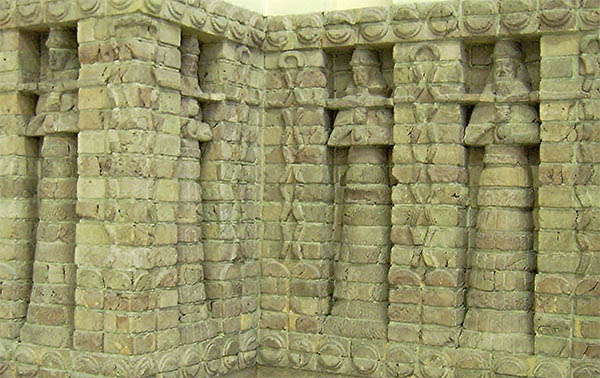
Located on the Euphrates in what is at present southeastern Iraq, Uruk is home to possibly the Sumerians' most of import temple to the gods, the White Temple and Great Ziggurat. Uruk was a major metropolis for early Sumerian culture and home to the swell Sumerian hero Gilgamesh who features in the famous epic poem of that proper noun, one of the earliest examples of narrative that survives today.
The remains of one of the nearly of import temples of aboriginal Sumer now bakes in the Iraqi sun. For tourists, historians and archeologists, a great deal of imagination is required to picture the ziggurat every bit it really was 5,000 years ago. Time, sun, air current, and erosion has taken its toll on the construction, merely from writings and by archeological extrapolation, we tin can build upwardly a pic of what the structure looked like at the meridian of Sumer's power.
Similar many other cultures, the Sumerians believed the gods lived in the sky, so they constructed many of their temples on the highest point possible and fabricated them as alpine as the building applied science of the time allowed. A ziggurat is a stepped pyramid. In this example, information technology is a broad i with a large, apartment surface area at its apex where a massive temple was erected. Hither, priests would offer prayers and sacrifices to the gods, and receive messages from the deities themselves.
The White Temple was 40 anxiety loftier (12 meters), built of brick (usable stone was rare in the region), and comprised an area of 56 x 72 square feet (17 ten 22 square meters). Historians guess that it took ane,500 laborers five years to construct the temple. Inside the temple, archeologists accept found the burnt skeletal remains of a leopard and a panthera leo, a number of stone tablets reflecting the accounting of the temple, and a fire pit where it is believed that burnt offerings were given to the gods. Additionally, they believe they have found evidence of a fountain or h2o arrangement inside the temple, which indicates a level of technological understanding beyond that which nosotros would normally associate with very ancient times.
8. Statues of Tell Asmar
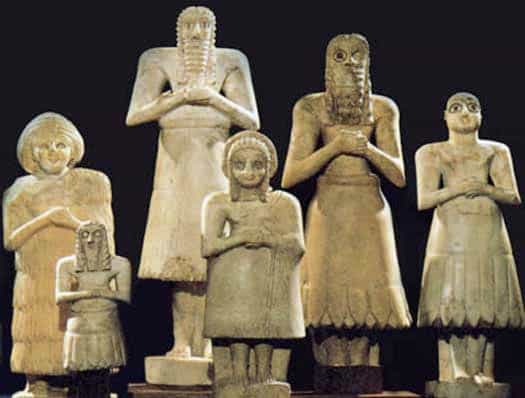
In the 2009 movie The Fourth Kind, a psychologist works with people who have allegedly been abducted and their bodies inhabited by aliens and subjected to all sorts of terrors. Presently, she is visited past these aliens herself and begins to record their visits. She also hires a team of UFO experts to help her go to the lesser of the mystery. One of these experts is a historian who has traced alien abduction and visitation stories throughout history. It is his belief that beings from another planet have been visiting the earth for thousands of years. To "prove" his theory, he points out diverse statues and friezes of the Sumerian and other Mesopotamian cultures such as the Elamites of the powerful city of Eshnunna.
2 of the figures he believes might be depictions of aliens are the votive statues of Tell Asmar from around 2700 BC. Their big eyes are similar to those that we associate with visiting aliens. Other plausible-sounding similarities are concocted to lead the states to believe that perhaps aliens have been visiting and ruling over us for centuries.
The true story of the figures is this: Simply as worshipers light a candle and say a prayer to call back their loved ones in some Christian churches today, these statues represented the deceased. In many cases, names have been found on the bottom of the figures, along with a written prayer. The twelve figures of Tell Asmar (ten men and two women) were found shut together in a temple area. Information technology is believed that the wide, conflicting-similar eyes of the statuettes were to brand sure that they were able to meet any messages or responses given by the gods, no matter how minor or subtle.
Eight of the statues are fabricated from gypsum, two from limestone and one from alabaster. The dark, oversized eyes are made from bitumen (coal) and one figure'south pupils are made from lapis lazuli. The beards of the men and other dark markings and shadings on the figures were likewise inlays of bitumen coal.
7. The Standard of Ur
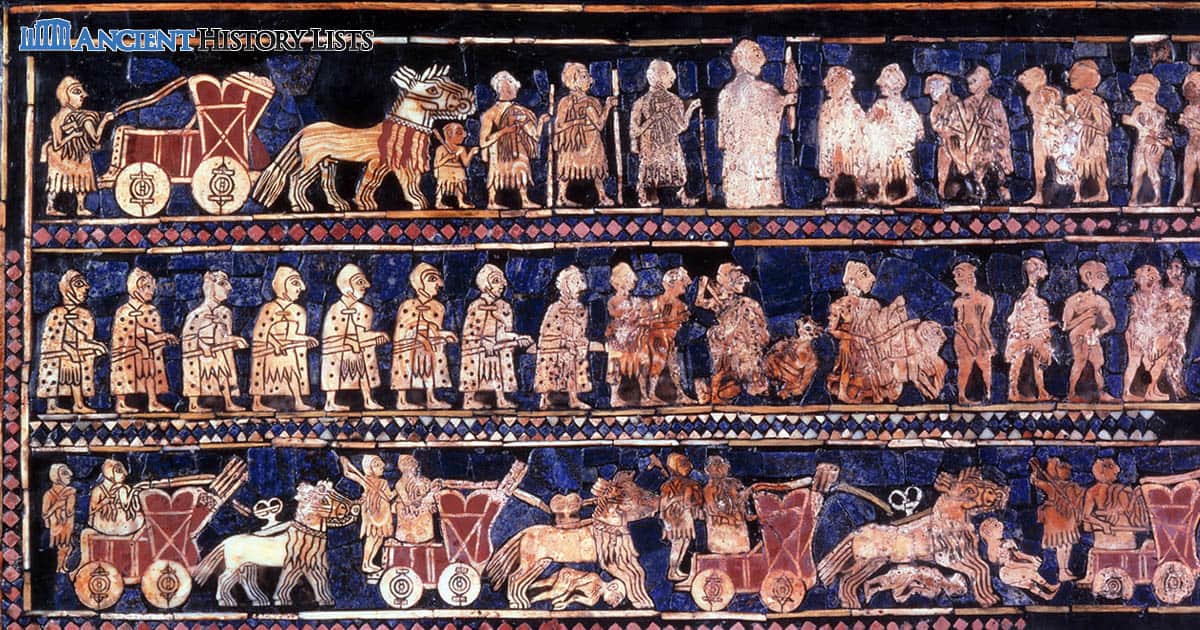
Found in the 1920s by British archeologists (Republic of iraq was so governed by Uk), the Standard of Ur is a cute piece of art that is 4,600 years quondam. The standard is actually a mosaic, not a piece of cloth as the name would advise. Though much of the piece has been lost to time and thieves, a significant portion of it exists today in the British Museum in London.
The Standard is made from crimson limestone and lapis lazuli (which forms the blue background). These materials were non cheap, and the mosaic was prepared for the tomb of a king, Ur-Pabilsag, who died effectually 2550 BC. The mosaic is a partial story of his life and reign and gives us an insight into Mesopotamian culture.
Originally believed to exist roofing a hollow, four-sided box, the mosaic is actually quite minor – 8.5 inches wide and 19.five inches long – but provides great detail about aspects of life in ancient Mesopotamia. The two surviving fragments have been labeled "War" and "Peace." The starting time shows the king, a two-dimensional, towering figure, viewing a procession of naked prisoners (some of them wounded) beingness marched past his chariot. Mesopotamian soldiers are shown in their helmets with weapons at the fix.
Nosotros too see a number of horse-fatigued chariots. From these images, we know what these soldiers wore, and with what (and how) they likely fought. The horses lack $.25 in their mouths as this was an invention that came a grand years later on. Instead, they were directed past other means such as ropes forth or inside the nose. Enemies are being paraded earlier them and are beingness trampled underneath the chariots.
The other fragment, "Peace," again shows an outsized king at the head of a banquet, which includes a singer, a lyre player, fish and other animals, as well as various fruits and vegetables.
vi. The Victory Stele of Naram-Sin
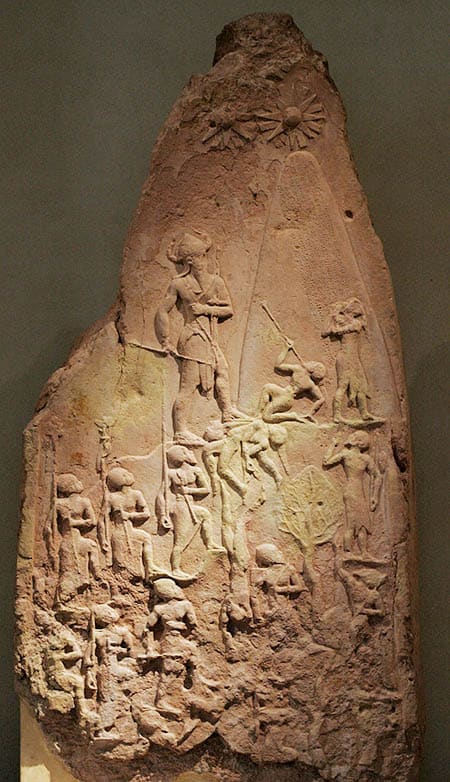
Another of the ancient Mesopotamian cultures was that of Akkadia, which ruled much of Mesopotamia from approximately 2334 BC to 2154 BC. The Akkadians controlled most of the length of the navigable parts of the Tigris and Euphrates rivers, which gave them great power. Like other civilizations throughout the centuries, the Akkadians erected monuments in honor of their great kings and warriors and, in the process, elevated them to a sort of god-similar condition.
The Victory Stele of Naram-Sin commemorates the triumph of the Akkadian male monarch Naram-Sin over the Lullubi who lived in the Zagros Mountains of nowadays-day Iran. Nosotros can tell a lot about Rex Naram-Sin just from looking at this stele. Most of the military/triumphant friezes of Mesopotamia and later are horizontal, with the king marching or riding at the front or rear of a procession of soldiers, priests, and/or prisoners. In this example, the stele depicts the victory of Naram-Sin in an upward, semi-triangular manner, with the king at its noon and much larger than the figures below him, which decrease in size as you become closer to the lesser of the stone.
The Akkadians believed that only deceased kings became gods, but here Naram-Sin is wearing the helmet of a god and his face is depicted as that of a lion, something which other works tell united states of america is reserved only for the gods. Similar many conquerors that came after him, Naram-Sin must accept had some ego.
5. Ashurbanipal and His Queen in the Garden
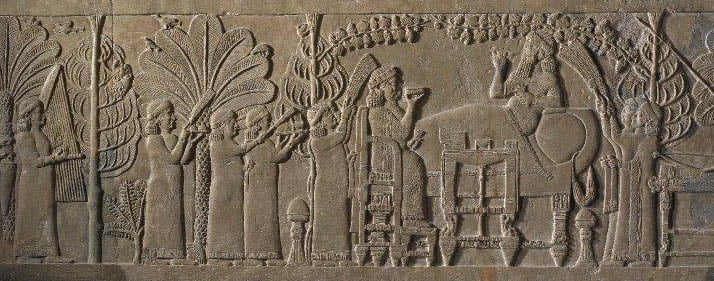
Ashurbanipal was king of the Assyrian Empire from 668 BC to 627 BC, a relatively recent rex compared to those we accept already mentioned. Actually, if you think only in terms of time, the reign of Ashurbanipal is closer on a timeline to the states in today than to the people of Ur 3,200 years ago.
In this frieze of the male monarch and his married woman, we run into life in the royal court in a different setting. Here the king and queen are relaxing and enjoying themselves. This shows that the queen must accept either been quite important or the king must have loved her a great deal – or both. Queens did non appear in Assyrian art with much frequency, unlike the Egyptian art nosotros are more than familiar with.
Speaking of Egypt, we tin see weapons in the background of the frieze which indicate perhaps a recent campaign against the Egyptians. We see vino goblets, fruit, slaves, and a severed head in the background. Nosotros can also run across incense burners and slaves fanning away the desert flies. Some historians take noted that in this piece of work, the faces of the king and queen (who are rendered in an almost three-dimensional manner) have been defaced, while the faces of the slaves and servants have non. This leads historians to believe that Ashurbanipal and his queen must take been hated figures.
4. The Balderdash Lyre
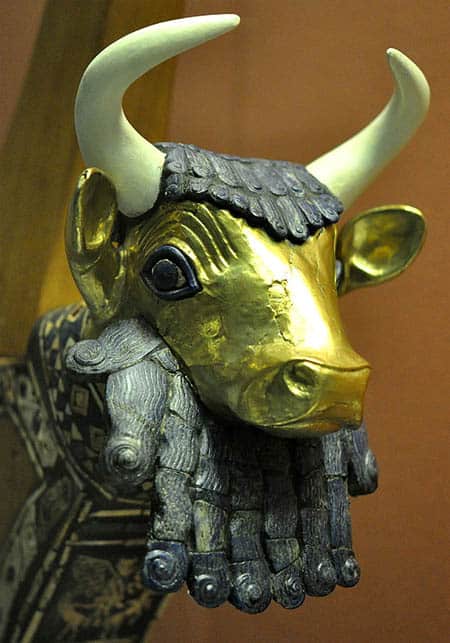
One of the most beautiful pieces of art recovered from Mesopotamia is the Bull Lyre. Institute in the tomb of Queen Puabi (c. 2680 BC), the lyre was meant to assist the queen fend off loneliness in, and on to the journey to, the afterlife. The lyre is 112cm high, 73cm long, and the body is 7cm wide. The body is a sort of rectangular box continuing on 1 of its lower sides, out of which the body of the lyre grows. The front of the lyre is adorned with the face of a blue bull (created by a lapis-lazuli inlay), and downward the front end of the bull'southward chest are depictions from scenes at court. Whether the lyre was actually playable when created is unknown.
3. The Stele of Hammurabi
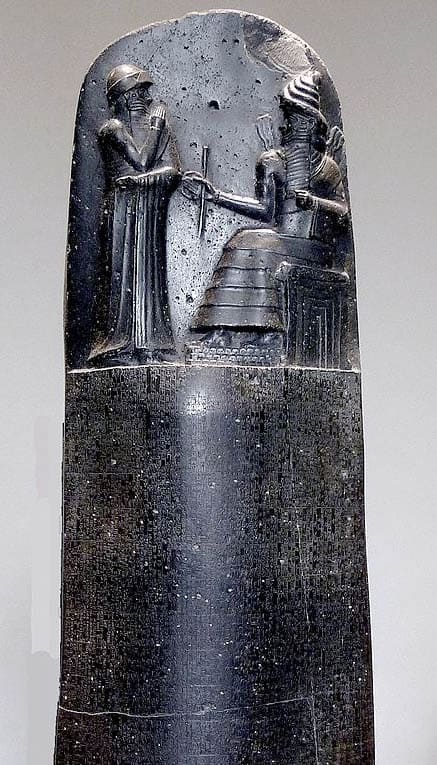
Hammurabi is one of the almost famous of the ancient kings. He ruled Babylon from 1810 BC to 1750 BC and is responsible for 1 of the only (and first) surviving written codes of law. Supposedly given to him by the god Shamash, the Hammurabi Code details laws surrounding many aspects of life in ancient Babylon, and the laws were carved into a stone stele so that they could be seen past everyone. By etching his laws on this stele, Hammurabi was also making a statement that would be remembered well into the future. Hammurabi was declaring that the law should not exist arbitrary and made on a whim. Although a work of government, the stele has since taken on an aspect of art, largely due to its utilize of cuneiform.
Cuneiform, meaning "wedge shaped" in Latin, was one of the earliest writing systems in history. Information technology began around 6000 years ago as a serial of pictograms and adult into a wedge-shaped or triangular alphabet for exactitude and understanding. Over time, artifacts from Babylonia and Mesopotamia engraved with cuneiform have been considered works of art. From the late 19thursday century through today, neo-primitive artists will include cuneiform writing in their work to add together atmosphere or meaning.
2. Lamassu
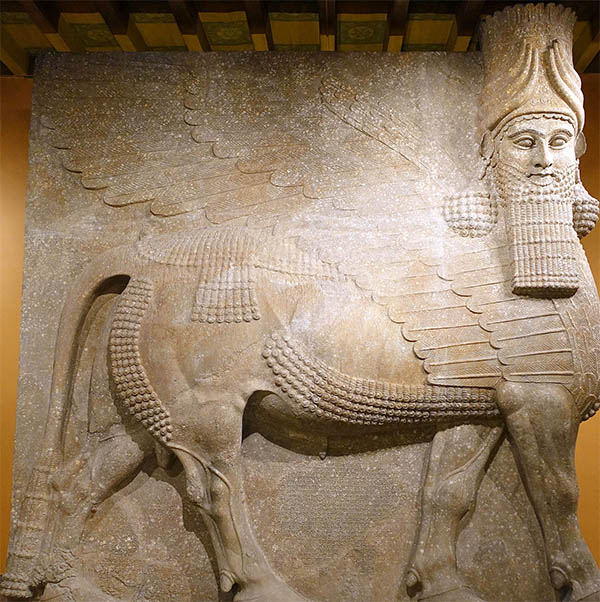
In Mesopotamian culture, the lamassu were protective gods with the heads of royal humans, the bodies of bulls or lions, and the wings of birds. Much similar the guardian lions, lion dogs, and dragons of China, the lamassu guarded temples and palaces to ensure no impairment would come to the king and priests and to make sure prayers were protected.
The faces of the lamassu (and in that location are a number of them still in beingness) are what most people acquaintance with the appearance of Mesopotamian rulers or priests. They vesture a large miter-blazon hat with a flat superlative (something like the headgear of Eastern Orthodox officials) and a long square-ended beard spun into curls. In much the aforementioned way as nosotros recollect of Rex Tut or the Sphinx every bit being typical of ancient Arab republic of egypt, people often acquaintance the face of the lamassu with the rulers of Mesopotamia.
Well-nigh of the surviving lamassu figures are large and imposing – they were supposed to exist, every bit they were the guardians of the temples and the gateways to the gods. The most famous pair of lamassu, at Sargon II's temple at Khorsabad in northern Iraq, stand much higher and wider than the people. Another interesting fact near these bull- or king of beasts-bodied guardians is that they oftentimes have 5 legs.
1. The Ishtar Gate
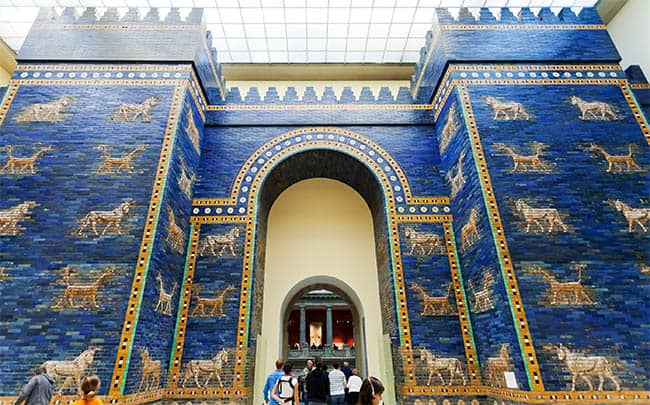
The Ishtar Gate, reconstructed and displayed in the Pergamon Museum in Berlin since 1930, was created during the fourth dimension of the longest-reigning Babylonian monarch, Nebuchadnezzar Ii (634 BC–532 BC). Found on the north side of the ruins of Babylon in disrepair, the gate was reconstructed using original bricks and repainted. Today, the Ishtar Gate is considered by many to exist the finest example of Mesopotamian art.
The gate itself is large: it is 14 feet high and 100 feet wide. Its crenellated towers show an architectural mastery, and its golden and xanthous mosaics indicated that ane was passing through into a rich and powerful city. From remnants of dyes and paints, restorers believe that the Ishtar Gate was colored, or topped, with lapis lazuli. The lapis-colored paint was expensive and indicates the importance of the structure.
Information technology is believed that the Ishtar Gate was merely the concluding structure on a long road leading into the n side of the urban center. Historians and archaeologists believe that the road leading to the gate was lined with miniature castle towers, all crenelated like the top of the Ishtar Gate – whether this was purely aesthetic, to protected archers, or both is uncertain.
Source: https://www.ancienthistorylists.com/mesopotamia-history/outstanding-mesopotamian-art/
0 Response to "First King to Appear as a God in Mesopotamian Art Was"
Postar um comentário